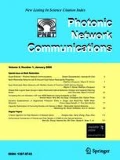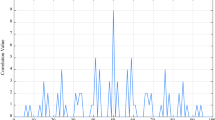Abstract
The performance of an optical code division multiplexing access (OCDMA) system employing the differential phase shift keying (DPSK) data format and turbo code is investigated and simulated. A bandwidth-limited coherent time spreading (TS) OCDMA system is considered. Theoretical results show that performance degradation due to bandwidth limitation could be effectively restrained by the application of the DPSK data format in a coherent OCDMA system, and further performance improvement could be achieved by incorporating turbo coding into the OCDMA system.
Similar content being viewed by others
References
Kitayama K., Sotobayashi H. and Wana N. (1999). Optical code division multiplexing (OCDM) and its application to photonic networks. IEICE Trans. Fundam. Electron. Commun. Comput. Sci. E82-A(12): 2616–2626
Sampson D.D., Pendock G.J. and Griffin R.A. (1997). Photonic code-division multiple-access communications. Fiber Integr. Opt. 16(2): 129–157
Wang X. and Kitayama K. (2004). Analysis of beat noise in coherent and incoherent time-spreading OCDMA. IEEE/OSA J. Lightw. Technol. 22(10): 2226–2235
Teh P.C., Petropoulos P., Ibsen M. and Richardson D.J. (2001). A comparative study of the performance of seven- and 63-chip optical code-division multiple-access encoders and decoders based on superstructured fiber Bragg gratings. IEEE/OSA J. Lightw. Technol. 19(9): 1352–1365
Cincotti G. (2004). Design of optical full encoders/decoders for code-based photonic routers. IEEE/OSA J. Lightw. Technol. 22(7): 1642–1650
Chen X., Huang D., Yuan X. and Xia G. (2007). Grating-based 40-Gbit/s optical code-division multiplexing system incorporating a nonlinear amplifying loop mirror. Opt. Eng. 46(1): 015006-(1)–015006-(5)
Wang, X., Wada, N.: Performance Degradation in Coherent OCDMA due to Receivers’ Bandwidth Limit and Improvement by Using Optical Thresholding. IEEE/LEOS 2005 Annual Meeting, Sydney, Australia pp. 638–639 (2005)
Xu C., Liu X. and Wei X. (2004). Differential phase-shift keying for high spectral efficiency optical transmissions. IEEE J. Sel. Top. Quantum Electron. 10(2): 281–293
Liu X., Kao Y.H., Movassaghi M. and Giles R.C. (2004). Tolerance to in-band coherent crosstalk of differential phase-shift-keyed signal with balanced detection and FEC. IEEE Photon. Technol. Lett. 16(4): 1209–1211
Sergio B. and Guido M. (1996). Unveiling turbo codes: some results on parallel concatenated coding schemes. IEEE Trans. Inf. Theory 42(2): 409–428
Claude B. and Alain G. (1996). Near optimum error correcting coding and decoding: turbo-codes. IEEE Trans. Commun. 44(10): 1261–1271
Author information
Authors and Affiliations
Corresponding author
Rights and permissions
About this article
Cite this article
Chen, X., Chen, D. & Wang, Z. Performance improvement of bandwidth-limited coherent OCDMA system. Photon Netw Commun 16, 149–154 (2008). https://doi.org/10.1007/s11107-008-0126-1
Received:
Accepted:
Published:
Issue Date:
DOI: https://doi.org/10.1007/s11107-008-0126-1




